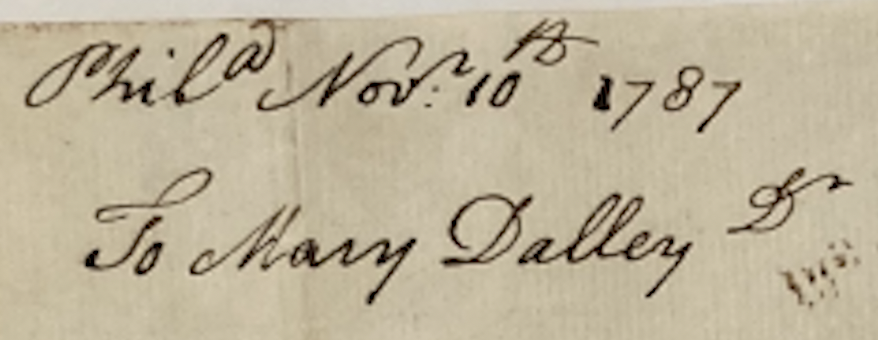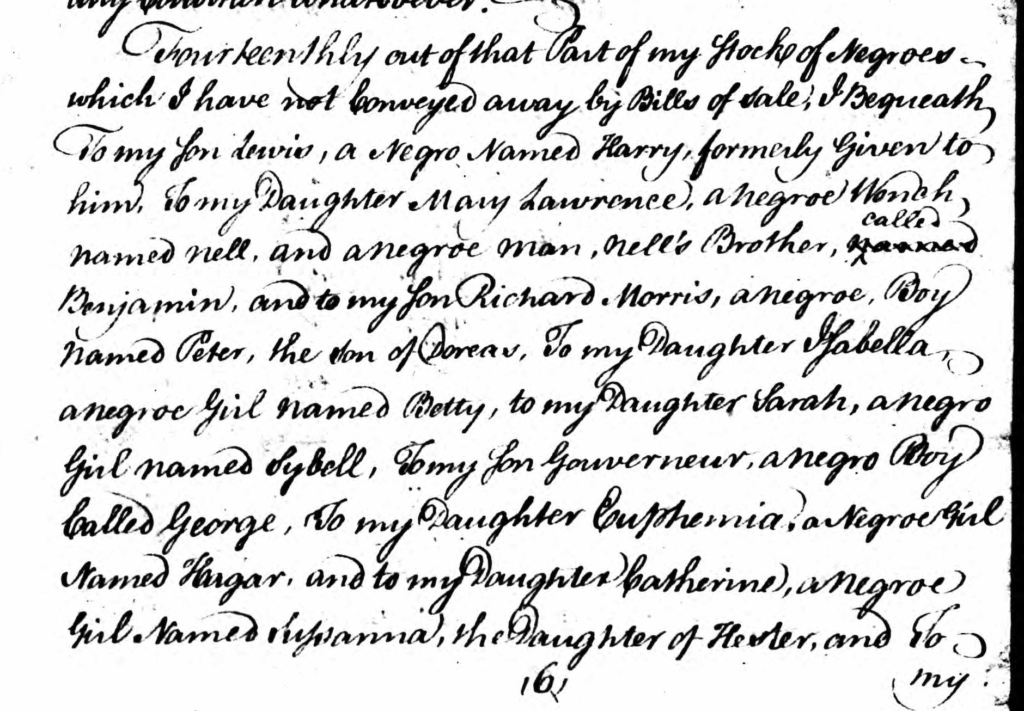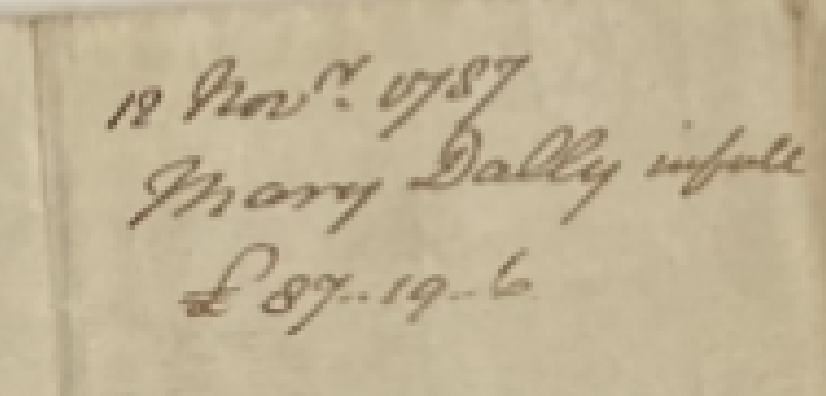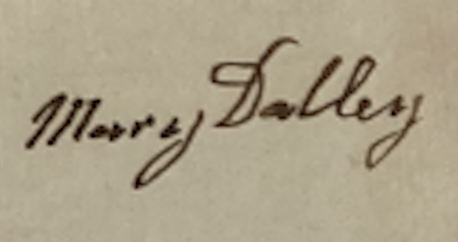Breaking News: Long-sought receipt from the Constitutional Convention has finally been located
Needle in a haystack conclusively proves that Gouverneur Morris boarded at Miss Dally’s boarding house
After countless hours of sleuthing through archival records, it is no exaggeration to announce that a needle in a haystack has been found. Statutesandstories.com is pleased to report that a recently located receipt provides definitive proof that Gouverneur Morris in fact boarded with Miss Dally/Dalley during the Constitutional Convention.
As described below, the enormously significant but long-overlooked receipt confirms where the “penman of the Constitution” boarded during the summer of 1787. The receipt was discovered in the archives of the American Philosophical Society in Philadelphia. As far as can be determined, the 10 November 1787 receipt has never been described in print or online until now.
Background
Thomas Jefferson drafted the Declaration of Independence at the “Graff House” located on the corner of Market and 7th Street in Philadelphia. Today, the carefully reconstructed building is a national treasure operated by the Park Service. Yet, there is nothing on Market Street between Second and Third commemorating Miss Dally’s boarding house where Gouverneur Morris resided when he penned the 12 September draft of the Constitution. Indeed, it is entirely possible that Morris may have drafted the Preamble at this location.
Gouverneur Morris is universally regarded as the “penman of the Constitution.” He was selected by the Committee on Style to prepare the September 12 draft of the Constitution, which included the Preamble. During the Covid-19 pandemic Statutesandstories assembled the following archival records to solve the mystery of where Gouverneur Morris boarded in 1787:
- Bank records located in the Morris Papers at the Library of Congress provided strong evidence of payments by Gouverneur Morris to Miss Dally, but did not identify the purpose of the transactions. As described in Part I, periodic payments between Morris and Dally dated back to 1781.
- Francis White’s 1785 street directory indicates that Gouverneur Morris and Miss Dally lived on the same block (Market Street between 2nd and 3rd). Part II also provides details about Miss Dally’s backstory.
- Property tax rolls in 1781, 1786 and 1787 further confirmed that Miss Dally and Gouverneur Morris lived in close proximity. Part III summarizes that Miss Dally was paying the taxes for the building on behalf of the owner, Bartholomew Wistar. By contrast, long-term residents Gouverneur Morris and Dr. John Jones were clearly subtenants.
- Part IV presented the “Committee on Style Venue Hypothesis” which theorizes that Miss Dally’s boarding house would have been the most convenient, central location for the Committee on Style to meet between September 8 to 12.
- Part V presented as yet unanswered research questions.
- Correspondence by Doctor John Jones and Elbridge Gerry relating to Miss Dally’s boarding house is discussed here (Case Closed) in what was expected to be the last essay in this series of blog posts.
Receipt dated 10 November 1787
The detailed receipt from Miss Dally discovered in the archives of the American Philosophical Society is fully consistent with the above-described records located at the Library of Congress, Columbia University, the New York Public Library, the Massachusetts and Pennsylvania State Archives, and other research institutions.
The receipt could not be clearer. Miss Dally provided “board and lodging” to Gouverneur Morris during the following months in 1787:
- 15 December 1786 to 20 April 1787 (18 weeks);
- 20 April 1787 to 31 May 1787 (6 weeks);
- 30 June 1787 to 21 September 1787 (12 weeks);
- 28 October 1787 to 11 November 1787 (2 weeks).
The Constitutional Convention met from May 25 through September 17. Based on Max Farrand’s work, it has been widely understood since 1911 that Gouverneur Morris departed the Constitutional Convention for New York during the month of June, returning to the Convention on July 2. The 1787 receipt bears out this long-held understanding. Despite his absence for an entire month, Morris spoke more times than any other delegate at the Convention (including James Madison and James Wilson).
The receipt also shines new light on Miss Dally:
- The receipt demonstrates that Miss Dally was not only literate but also numerate. The three columns of numbers (pounds, shilling and pence) suggest that Miss Dally had no difficulty converting between different denominations of currency prior to the introduction of decimalization under Treasury Secretary Alexander Hamilton.
- The handwriting is consistent with other receipts located in the Massachusetts State Archives from the 1780s (pictured below);
 Pictured above are receipts by Miss Dally to Samuel Adams and Artemus Ward from 1780
Pictured above are receipts by Miss Dally to Samuel Adams and Artemus Ward from 1780
- As the 1787 receipt was signed by (and presumably prepared by Miss Dally), this suggests that she ran the boarding house, rather than her sister, Miss Clark. Miss Clark and her cooking features prominently in correspondence by Elbridge Gerry and Doctor John Jones;
- Consistent with other primary sources and correspondence, the receipt confirms that Miss Dally was not only an entrepreneur but also a skilled tailor, as she charged Morris for “mending shirts” and making stockings. Apparently, Gouverneur Morris was partial to the linen fabric, Cambric, as Miss Dally charged him for 4 1/2 yards of the material.
Nevertheless, the receipt raises several questions which are only touched on below:
Who was Gouverneur Morris’s servant?
Interestingly, Miss Dally charged Morris for “board and lodging for yourself and servant” from December 15, 1786 to April 20, 1787. Thereafter, Miss Dally only charged Morris for board and lodging “for yourself.”
Did Gouverneur Morris discharge his servant prior to the Convention? Was the “servant” a paid employee, indentured servant, or a slave (who Morris freed prior to the Convention)? Or did Morris send the servant back to Morrisania in anticipation of the Convention? As Morris is universally recognized to be the most outspoken opponent of slavery at the Convention, it is unlikely that he owned a slave during the Convention. With that said, he may have inherited a slave when his mother died in 1786.
According to his father’s will from 1760 (pictured below), Gouverneur was devised “a negro boy called George.” It is as yet unclear when he manumitted George, but Morris biographers affirm that Morris did so well before his death. Moreover, while serving as the American ambassador to France, Morris employed a servant named Martin (who spoke both French and English).
The November 1787 receipt indicates that Morris continuously resided in Philadelphia at Miss Dally’s boarding house from 15 December 1786 through 31 May 1787. Yet, boarding/lodging for the servant ended on April 20. Thus, the trusted servant may have returned to Morrisania to continue work on the estate, which had been recently acquired by Gouverneur Morris in 1787. Click here for a discussion of Morris’s acquisition of Morrisania in early 1787. Click here for a discussion of the discovery that New York Governor George Clinton and Senator Philip Schuyler were retained as arbitrators to help resolve the Morrisania probate litigation.
While the 1787 receipt has yet to be exhaustively analyzed, it appears that different rates were charged during different time periods. From December 1786 to April 1787, when boarding and lodging were being provided to Morris and his servant the rate was 6 (?) per day, totaling 54 pounds for 18 weeks through April 20. By contrast, the rate was only 4 (?) per day thereafter, when board and lodging was only provided “for yourself.”
Monetary questions
Presumably the total balance incurred of 87 pounds, 19 shilling and 6 pence was British currency. If so, this is a rather large sum. For example, the salary of the Lt. Governor of Pennsylvania (Vice President of the Supreme Executive Council) was only 500 pounds.
It is unclear when the balance was paid. The back of the receipt suggests that the invoice may have been paid in November of 1787, but the November 12 date might only be the date through which boarding and lodging services were provided? In Part I it was previously suggested using his bank records at the Library of Congress that Gouverneur Morris finally paid Miss Dally the sum of $234.54 on 15 January 1788. Does the 87 pounds, 19 shilling and 6 pence balance from November of 1787 correspond to $234.54 with interest paid in January of 1788?
Spelling and Pronunciation
It is becoming clear that Miss Dally spelled her name with an “e” (“Dalley”). Yet, Gouverneur Morris, Elbridge Gerry, Doctor Jones and others routinely spelled Miss Dally’s name without the “e.” Her name is variously shown in the tax rolls as Daley, Dayly, and Dayley. As Miss Dally should have ownership of the spelling of her own name, the pending historic marker will refer to her as Miss Dalley and the boarding house as “Miss Dalley’s boarding house.”








